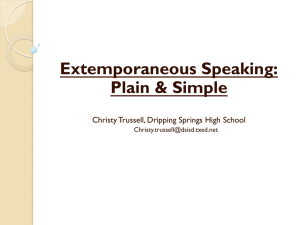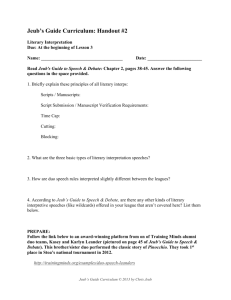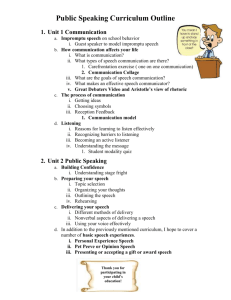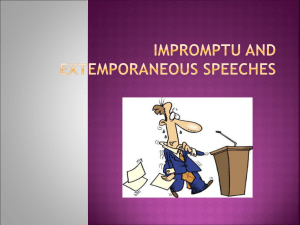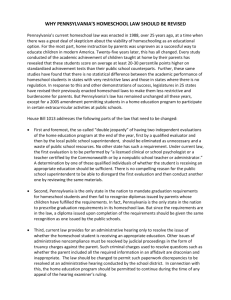Jeub's Guide to Homeschool Speech & Debate
advertisement
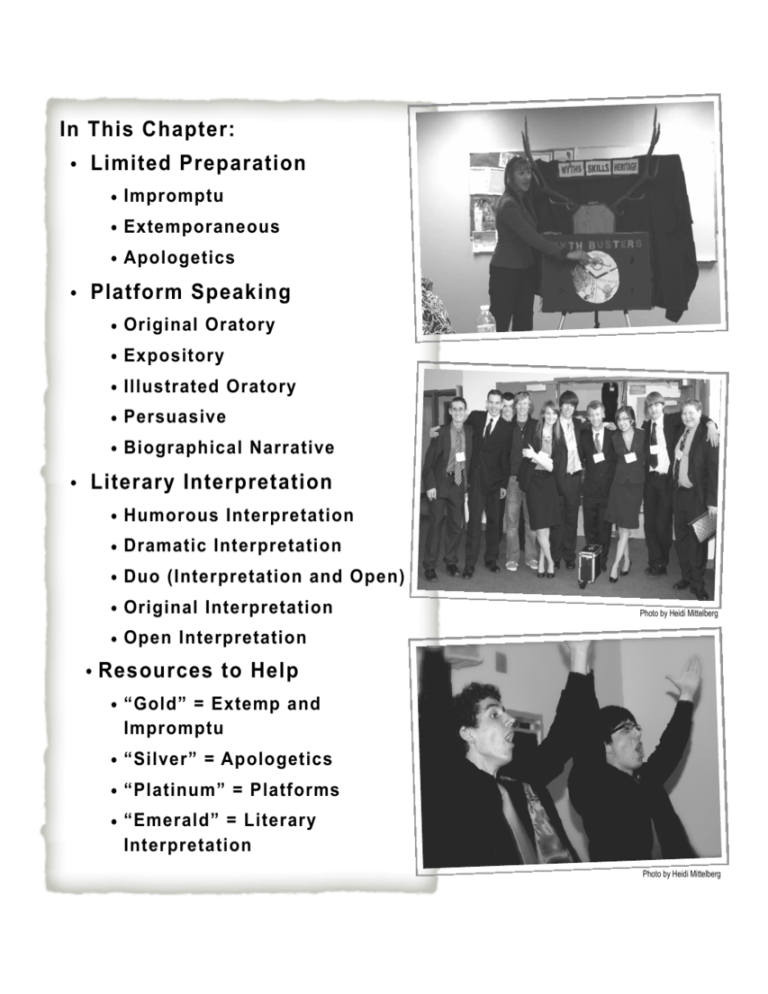
In This Chapter: • Limited Preparation • Impromptu • Extemporaneous • Apologetics • Platform Speaking • Original Oratory • Expository • Illustrated Oratory • Persuasive • Biographical Narrative • Literary Interpretation • Humorous Interpretation • Dramatic Interpretation • Duo (Interpretation and Open) • Original Interpretation Photo by Heidi Mittelberg • Open Interpretation • Resources to Help • “Gold” = Extemp and Impromptu • “Silver” = Apologetics • “Platinum” = Platforms • “Emerald” = Literary Interpretation Photo by Heidi Mittelberg CHAPTER 3 Speech The following chapters run down the different events offered in NCFCA and Stoa. It is important to note that Stoa comes out with its event rules in August, and the organization holds itself to these rules throughout the competitive year. No changes will be made. NCFCA does not have a disclosed date for rule changes, and it has a history of changing and clarifying them if problems arise and the leadership feels that tweaks are needed. In general you can rely on the following summaries, but it is wise to double check with the websites of the league you participate to make sure you understand the rules of the current competitive season. Tournaments will have a number of “individual events” for which students can register. By the end of the season, students will know these individual events very well, as they will observe them in competition. They’ll know them especially if they compete in them. And after students and parents understand what is demanded of them for each event, they will construct their homeschool accordingly. They will merge their current curriculum with the demands of their club and upcoming tournaments. As mentioned, don’t be concerned about speech and debate taking away from other schoolwork. Those who have been involved know how empty this www.trainingminds.org 32 Jeub’s Guide to Homeschool Speech & Debate threat is. Students who dive into individual events soon become experts in their field of study, and they typically thrive academically in a host of other areas. In fact, parents should creatively give credit where credit is due for speech events. A homeschool teacher is no different than a public school teacher in this respect. If a student is writing a speech on supply-side economics, well, perhaps the economics lesson can be waived. If what needs to be learned can be learned in the preperation for a speaking event rather than a textbook lesson, go with the speaking event. It’s a lot more fun and the student will retain the information much better. Students will learn to really work their pieces. Remember, the element of competition is looming ahead of them, and the desire to do well at the next tournament should serve as a proper motivator to keep polishing their work. This is true for all individual events, even limited-prep. As for my family, we roll virtually all language arts and civics into speech and debate. My children under 12 are taught most of the basics in grammar school, so when they reach competitive age, they are ready to apply their skills. Once a speech is selected or cut, the student needs to memorize it. Early tournaments may allow students to read a script, but this should be avoided as much as possible. Memorization is an important tool best learned when younger. Once memorized, the student has cleared the minimum standard for presenting the speech. It may take some reworking if a student would like to expand the piece or shorten its length. Judges are impressed when speakers hit the maximum allotted time of a speech category, so try your hardest to make that mark. (You’ll learn more about times for speeches later in this chapter.) www.trainingminds.org Speech 33 Now, let’s get into what these events actually are. There are 10 events offered in both organizations, each falling under one of three categories: limitedpreparation, platform speaking and literary interpretation. Limited-Preparation Students who develop their thinking skills are those who lead in their adult life. They think on their feet, which is a skill virtually everyone wishes they could master. Limited-preparation events are for the students who wish to master this skill. The name does not say it all in this category. For there is a fair amount of preparation required as students get ready for the limited-prep event. But the preparation is more practice than it is academic preparedness. That’s the part of it that’s referenced by “limited-preparation,” of which there are three individual events—impromptu, extemporaneous and apologetics. All students are given the equivalent topics for their speaking time. For example, in an impromptu round, all the competitors will be given similar quotes. Or in an extemp round, all students will be given, say, economic questions. The point is for the judges to rate the students fairly in how they present the material. Here is a summary of the criteria judges use in ranking a limited-prep event: 1. Content. Sure, students are given the topic or question, but how they stick to the topic is just as important. Basic development of thesis, examples and illustrations reflect on how good a rhetorical speaker they are. 2. Organization. Basic understanding of the structure of a speech (introduction, body, conclusion) is ranked here. 3. Rhetoric. How succinct are the words of the speech? Does the speech have a fair balance of ethos, pathos and logos? www.trainingminds.org 34 Jeub’s Guide to Homeschool Speech & Debate 4. Delivery. How good a speaker is the student? The list on the Stoa impromptu ballot lists energy, vocal clarity, eye contact, authentic style and natural movement. 5. Overall Impression. All the limited-prep ballots ask for the judge’s bottom line impression of the speaker’s speech. Impromptu The American Heritage Dictionary defines impromptu as “something performed or conceived without rehearsal or preparation.” An impromptu speech is a speech given “off the top of your head.” The student is given a creative word or topic and is allowed a limited amount of time to prepare a speech before delivering it. The topic is meant to be specific enough for students to draw from their own general body of knowledge, yet broad enough to allow them to give a strong speech on the topic. Here’s how the competition unfolds: The registered student walks into the room where three judges sit. The judges have prepared speech topics (slips of paper placed facedown on the table, or slips of paper in an envelope) and the student draws three. The timekeeper then starts the timer for a two-minute prep time. Two of the three are returned to the judges (or to the table or envelope). The student starts thinking through what she will say following the prep time, sometimes making notes on a scrap piece of paper. After the prep time is used, the student starts to speak. She must not refer to her notes taken during prep time, only the slip of paper which was provided before the round started. She is given five minutes to speak, and the timekeeper gives hand signals counting the time down. After the speech, the student shakes the hands of the judges and either leaves the room or sits to watch other competitors. Extemporaneous Another popular type of limited-preparation speaking is extemporaneous speaking, popularly referred to as extemp. Of all the individual events short www.trainingminds.org Speech 35 of debate (which technically is not an individual event), this is likely the most challenging. Instead of just thinking on your feet, the speaker is required to be resourceful and credible on their topic. Here, too, a speaker is given a choice of three topics, but he is given 30 minutes to an hour to prepare a seven-minute speech. The extemp draw is done in the extemp prep room at a tournament. The prep room is filled with boxes from extemp clubs whose members spend homeschool time filing articles. These are used by the student to research the topic during the halfhour or so of preparation. It’s a quiet room, overseen by a parent or coach, where students keep strict track of speaking times and when they are due to take their turn. Extemporaneous speaking requires research in current events. The high school student copies articles from popular newsmagazines and news sites, prints them, and files them according to topic. 2 This is more time consuming than impromptu, but it keeps the young person up-to-date with what’s going on in the world around him. Unlike the normal impromptu speech, the extemporaneous speaker is expected to quote sources from that research. During preparation, students are allowed a 3” x 5” index card to keep notes on. They scour the accumulated articles and develop an outline for their speech. They usually have only 30 minutes, but they know they will be ranked based on their background knowledge. Students are allowed to enter the judges’ room with only their index card to refer to. Daring students sometimes go off card with no aid at all. Extemporaneous speaking may require “limited” preparation at the time of the assignment, but speakers (or “extempers”) are not simply spewing words. Nor are extempers reciting carefully worded speeches. Extemp is a cross between impromptu and oratory. Extemporaneous speakers are experts 2 At the time of writing the 4th Edition, an exploratory committee is researching the possibility of electronic files used in the extemp prep room. Be sure to check your tournament rules to see if such technology is allowed. www.trainingminds.org 36 Jeub’s Guide to Homeschool Speech & Debate in the topic. They become informed and knowledgeable so much in their studies that when called upon to speak on the topic, they are confident, poised and educated. Apologetics Competitive apologetics has been an event since 2005. Its purpose is to encourage the study and delivery of the fundamentals of the Christian faith. Both the NCFCA and Stoa have 100 apologetics questions that relate to Christian doctrine. Judges at tournaments are often pastors or respected people of faith, but the apologist is required to address the question as if the audience is not in agreement. This is, at its core, a test of apologia, a strong defense of the Christian faith. Here’s how it works at a tournament: A competitor will enter a room and choose one of three topic from the judge (as is done in the other limited-prep events). The timer will start and the student is allowed four minutes to prepare. Two tools are at the competitor’s disposal—a Bible and a personal box with filed cards. Unlike extemp, the card files must be the individual student’s, not a shared box from a club. Students are encouraged to prepare, in their homeschools, answers to these questions on 4” x 6” note cards that they may refer to during the course of their round. Platform Speaking Young people naturally desire to express themselves, and a major focus of education should include the opportunity for self-expression within clearly defined guidelines. When a student writes an original speech and delivers it, she is taking a platform, hence the name of this type of event. There are several platform categories, each with their unique rules and guidelines for proper platform speaking. They are original oratory (for Stoa), expository (for Stoa), illustrated oratory (for NCFCA), persuasive, and biographical narrative (for NCFCA). www.trainingminds.org Speech 37 Judges rank students on the same five criteria used for the limitedpreparation event (content, organization, rhetoric, deliver and overall impression). All platform speeches are 10 minutes long and students are ranked among a room full of other platform speakers. Original Oratory (Stoa only) Known as OO, original oratory is when the student writes an original speech and delivers it. There are two types of oratory: the speech to inform and the speech to persuade. OO is considered the broadest type of platform, and though there is an event called “persuasive,” OO can include an oratory that is persuasive in nature. Writing a speech can be fun homework. Instead of sending Junior off to write an ordinary research paper on an event in history, have him write and deliver an interesting speech! If it doesn’t inform well, give him coaching tips to improve (versus giving him an F on the paper and sending him back to research). Using a speech to teach will drive your student into learning without him knowing it. Original oratories can be about objects (the Titanic, race cars, collections, hair styles), people (Patrick Henry, Pocahontas, Martin Luther King Jr., the apostle Paul), events (World War II, Election 2012, the signing of the Declaration of Independence), or concepts (how to bake a cake, rebuilding a carburetor). Whatever the student is assigned to speak on, their speech can jump-start interest that was not there, or it can be a fueling force behind a preexisting interest. The other platform categories available to students narrow the purpose of their speaking. Expository (Stoa only) An expository speech, or expos, includes the same purposes as the OO (pretty much whatever the student wants to speak about) but for one aspect: the speaker may use visual aids. Expository speeches are extremely creative www.trainingminds.org 38 Jeub’s Guide to Homeschool Speech & Debate speeches that typically use presentation boards on easels as props for the presentation. Students start creating their expos as an OO. I’ve coached many students to migrate their OO to an expos, especially if the speech is begging for a visual presentation. The great expository speakers are masters of showing and telling at the same time. There are some restrictions to expos. According to the Stoa rules: • No computers may be used. • The speaker must set up her own props without assistance. • Clothes [as in costumes] may only be used during the speech time. • No weapons, explosives or incendiary devices may be used as visual aids. • Neither people nor live animals may be used. • The speaking area must be left in the same condition as it was prior to the speech. One drawback to doing expos is the need to transport props from tournament to tournament. Boards get bent up easily, and shipping props cross-country can be exhausting through the tournament season. That aside, expos is one of the most creative individual events. Students who take on expos continually tinker with their props all year long, expanding on their impact and constantly modifying their speech. I often see judges clamor for expos ballots, for they are always impressed at how creative the presentations can be. www.trainingminds.org Speech 39 Illustrated Oratory (NCFCA only) Prior to 2010, NCFCA ran expos. But the league has now narrowed the scope of expos into what is known as Illustrated Oratory, or IO. The only visual aids allowed in IO are boards, the pieces that affix to the boards and an easel. More specifically: Illustrated Boards. The number of boards allowed are “3 to 10,” according to NCFCA rules. These must measure no larger than 20”x30” (the standard size of store-bought boards). Every speech is required to start and end with a blank board, though it can be the same board. • Easel. Tripod easels can be found at hobby shops and general stores. The easels cannot be modified for the speech other than a ledge for their boards and a visual aid box. • Visual Aid Box. These are handmade boxes attached to the back of the easel. They must have a lid, which must be able to close, thus restricting the size of the visual aids inside. The overall dimensions of the box (length + width + height) must be no larger than 35 inches, about the size of a shoebox. The visual aids retrieved from the box during the presentation may remain attached to the board they are associated with, but must not be showing at the end of the speech. Students who follow this protocol will experience the same need to walk the line between showing and telling as with expos. The purpose is the same: to present visually the platform speech. The advantage of IO reflects the disadvantage of expos: It is easier to transport the visual aids cross-country. The disadvantage of IO is the advantage of expos: The creative agility of the speaker is limited by more restrictive rules on creativity. Persuasive A speech to persuade is for those students with strong opinions or a fire in their heart to make a change in politics or thought. The power of persuasion www.trainingminds.org 40 Jeub’s Guide to Homeschool Speech & Debate is the power to change the world. If anything is needed in today’s culture it is the need for strong and persuasive Christian leaders. Aristotle established the ultimate exposé on persuasive speaking in The Republic. We learn from him that three necessities in a persuasive speech are ethos, pathos and logos. Ethos is the credibility of the speaker, typically the references or appeals to authority that the speaker makes throughout a persuasive speech. Pathos is the passion of the speaker, the excitement and the emotion he will inject into his speaking. And then there is logos, the logic of it all, the rhetorical connection the speaker makes that reasonably persuades the judge. A mixture of all three makes for the best persuasive speeches. A persuasive speech, alternately referred to as a PS or a pers, must appeal to the pathos while upholding a credible ethos. Research and documentation are necessary ingredients for a persuasive speaker. We rarely assign a research paper as often as a research speech in our schools. The motivation to research and study the assigned topic is much greater when a speaking event is anticipated by the student. Biographical Narrative (NCFCA only) NCFCA has eliminated Original Oratory from their competition, replacing the third slot of platform speeches with biographical narrative. It is brand new to NCFCA competitors. According to the NCFCA website: “A Biographical Narrative is an original platform speech that focuses on the relevance and/or contributions of a single person’s life. The following goals could be served by the speech: informing, inspiring, persuading, entertaining, or teaching among others. The primary goal of the event is to encourage student recognition of those individuals that have impacted us in profound ways.” www.trainingminds.org Speech 41 Literary Interpretation Literary interpretation students perform a piece of literature for an audience. Homeschool students naturally fall in love with stories—fiction, biographies, plays—and will desire to share those stories with others. With interpretation, they have the opportunity to do so. And while they’re at it, students will develop their own understanding of the literature and, more significantly, develop skills to communicate the worth of the literature. There are several types of interpretative speeches, and both the NCFCA and Stoa organizations have created their unique presentation formats. I’ll get to the differences, but first let me highlight the principles of all literary interpretation speeches. Students are tasked with creating scripts from published literature (the only exception being Open or Original Interp where students can use original or unpublished works of literature). Students are not allowed to use one script for more than one year, and a script can only be entered in one event per tournament. Scripts have original word limitations and editing standards, and students need to keep a close eye on the event rules to make sure they are within the guidelines. • Students are required to submit their scripts physically to the tournament. Both NCFCA and Stoa have guidelines for script submission on their websites. Competitors are expected to have their scripts memorized, and judges are instructed to drop competitors two ranks if a physical script is used in the round. • All the literary interpretation speeches are capped at 10 minutes long, no minimum. Judges are given flexibility to that maximum time in case audience participation (like laughter) drags the speech past the limit. The best competitors aim for the 10-minute mark. • Students are tasked with cutting pieces of literature. Cutting requires reading through, then utilizing the cut-and-past tool in a wordwww.trainingminds.org 42 Jeub’s Guide to Homeschool Speech & Debate processing program to excise parts of the literature to make it suitable for presentation. This must be done without disrespecting the content of the original piece. Guidelines on how to do so are in Travis Herche’s excellent book, Keys to Interp: The Oralization of Literature (Monument Publishing), and can also be deciphered in the league rules. • Students are also tasked with blocking their piece. Blocking is the interper’s method of acting out the piece. The interper often jumps between narration and character, and perhaps among several characters, too. The rules forbid competitors from using props, and only the speaker’s feet are allowed to touch the floor, so the physical challenge of interpers are great (and impressive!). Interpers become masters of the space in the competitive room. Few of the competitive events are as impressive as the literary interpretive events. Students come alive in front of the judges. If you’ve never seen one of these events, visit YouTube and do a search for literary interpretations. Some of the recordings will certainly entertain you, and you’ll simultaneously get an idea of how to do literary interpretation for competition. Literature is art, and art can be crafted in ways that it puts people off. Competitors sometimes try to push the boundaries of decency, a tactic that doesn’t always impress the judges. Bathroom humor or crass jokes aren’t shined on in humorous interpretation among homeschool competitions. Likewise, dramatic pieces that shock or are generally inappropriate are discouraged. The best competitors will select pieces that are well written and challenging, avoiding the ones that are inappropriate. Those are the basics. Now we’ll move on to the details of each of the literary interpretation events. www.trainingminds.org Speech 43 Humorous Interpretation The name speaks for itself: humorous. The intent of the humorous interpretation, or HI, is to make the audience laugh. This is more than just a rattling off of jokes or stand up comedy. Instead, the student will lead the judges through a humorous script. Dramatic Interpretation (Stoa only) This name speaks for itself, too: dramatic. The intent of the dramatic interpretation, or DI, is to tell a dramatic story. The DI is not necessarily void of humor, but the intent isn’t to make you laugh. Instead, its purpose is to walk the audience through the drama of the story. NCFCA has eliminated the specific event to DI for the next school year. Students are still able to compete with a dramatic piece, but it will need to be run as an open interpretation. Duo Duo means what it implies: two competitors speaking together in one speech. Both NCFCA and Stoa have their variations of the duo event. The differences are easy to misunderstand, but are significant in preparing for competition. Duo interpretation (NCFCA only) is just like HI and DI, only done with two people. The duo competitors block their speech to never touch each other or look at each other (as the rules dictate). The duo competitor cuts scripts just like the HI and DI competitors do, the only difference being the dual nature of the presentation. Duo open (Stoa only), or DO, is a new form of duo interp. The rules for duo follow the same strict literary interpretation as HI and DI with rules as to how many original words may be used. Duo open allows speakers the flexibility of the open interp. Pieces may be original and insertions are allowed. Read the rules on Stoa’s website for complete information. www.trainingminds.org 44 Jeub’s Guide to Homeschool Speech & Debate Original Interpretation (NCFCA only, Stoa Wild Card) The NCFCA has eliminated thematic interpretation, an event that lasted only two years. Replacing it is original interpretation, an event that places creative pieces written by individual students in its very own category. This is a brand new category that will be offered this upcoming year. According to the NCFCA website, an OrI “creatively explores and develops the intellectual, emotional, and artistic embodiment of literature written by the student for performance.” Stoa members voted for their choice of a “wild card” event in July 2011. A wild card is an event that is run for one year, has its unique set of rules, and is not anticipated to become a permanent event. Of the three events voted on was (lo and behold!) original interpretation, and it won the vote. Competitors may run original interpretation in Stoa and NCFCA alike. Open Interpretation NCFCA has brought back open interpretation, or OI, as a literary interpretation event, and Stoa has had it since its inception. Open is exactly what it sounds like: everything not covered in the other interpretive events. Students must cite their sources throughout their OI, even if it is self-written. OI students may not use scripts and will be penalized if they do so. There is a slight difference between NCFCA OI and Stoa OI. NCFCA OI competitors may not use original pieces; those pieces would be run in original interpretation. Stoa competitors who wish to run original pieces will need to run them in OI as they have in year’s past, but, as previously explained, they also have the option to run their original pieces in original oratory. www.trainingminds.org Speech Event Category NCFCA Stoa Limited Preparation Impromptu Extemp Apologetics Impromptu Extemp Apologetics Platform Speaking Biographical Narrative Illustrated Oratory Persuasive Original Oratory Expository Persuasive Literary Interpretation Humorous Interp Duo [Interp] Open Interp Original Interp Humorous Interp Duo [Open] Open Interp Dramatic Interp Wild Card 45 Original Interp In summary, both leagues have several opportunities for homeschool students. Resources to Help There’s a lot of detail in all of this. But I hope you’re less confused than when you started. We’re in the business of making the confusion less confusing. Our line of curriculum does just that. And the following list of resources available for you at www.monumentpublishing.com is designed to help make this an enjoyable activity for you and your family. We color-coordinate our resources, making it easy to remember what resources go to what event. “Gold” = Extemp and Impromptu Monument Publishing’s sister ministry, Training Minds Ministry, has had the privilege of collaborating with the topmost extemporaneous and impromptu speakers in the history of the NCFCA and Stoa. These competitors have become some of the best coaches in the country, and they head up our Gold line of products. www.trainingminds.org 46 Jeub’s Guide to Homeschool Speech & Debate Cody Herche (2006 NCFCA extemp champion) introduced the Gold Book in 2009 as an overview of domestic, world and economic news. For the novice extemper, the Gold Book is invaluable. These past few years, Cody has brought on Shane Baumgardner (2010 NCFCA extemp champion), and Shane likewise has brought on the top award winners in extemp. They all serve as writers for the Gold Book. The Ironman Curriculum includes “Gold Curriculum,” a 4-week introduction to extemporaneous speaking. It is written by Shane and includes a lesson on impromptu speaking, something he won two titles in as a high schooler. There are a few other extemp products. Keys to Extemp: Speaking From the Heart With the Knowledge in Your Head is our full-length textbook for the serious extemp speaker. It is written by Cody and is referenced in the curriculum. There are also handy resources like “Gold Cards” (perforated cards with a handy method of note-taking for the extemper) and the “Training Minds Timepiece,” an electronic timer designed to help students master the art of the six-minute extemp speech. “Silver” = Apologetics Apologetics is vast and wide, allowing for a myriad of options for students to jump into. Training Minds Ministry and Monument Publishing have been blessed with some outstanding coaches that are masters at simplifying the immensity, and they have preselected great sources from which to start. Apologetics competitors need to get the Silver Book. We released our second volume this summer, and we have a ongoing strategy of fleshing out new editions every couple of years or so, giving a wide variety of resources for the apologetics family to choose from. The first volume, Silver Book: Systematic Theology Edition, is written by the Rev. Chap Bettis, a pastor and homeschool father from Rhode Island. It breaks down three different resources for the apologetics competitor. These resources are bestsellers in the apologetics field: (1) Systematic Theology by www.trainingminds.org Speech 47 Wayne Grudem, (2) Know What You Believe by Paul Little, and (3) Case for Faith by Lee Strobel. By the time students are finished with their lessons, they will have a solid foundation from which to build their competitive speeches. The second volume is Silver Book: C.S. Lewis Edition. It is written by two of Bettis’ graduated students, Luis Garcia and Cynthia Jeub. They accomplish the same goals as Volume 1 (walking the student through resources with the intention of preparing them for apologetics competition), but they apply The Complete C.S. Lewis Signature Classics by C.S. Lewis and The Questions Christians Hope No One Will Ask by Mark Mittelberg. Note that both volumes stand alone. Students can jump into Volume 2 without training in Volume 1. The volumes merely reflect the order in which they were published. Ironman Curriculum comes with both apologetics curricula, referencing both volumes of the Silver Book. Therefore, teachers can use the one curriculum for either volume. These curricula are also sold separately. I have found that coaches sometimes teach only apologetics, as this was the case with the Rev. Bettis. There is one other peripheral for “Silver” competitors: “Silver Cards.” These are basically 4” x 6” index cards, but come with a handy template for easy speechwriting and printing. These cards come packaged with each available Silver Book bundle. “Platinum” = Platforms I have a special fondness for platforms. I believe these speeches serve as a culmination of the homeschool pedagogy more than the other events. Platforms replace term papers all the time in our homeschool, and they should. Students still must go through their research motions, but the adrenaline of preparing a thorough speech for competition elevates the enthusiasm far higher than any school project will. www.trainingminds.org 48 Jeub’s Guide to Homeschool Speech & Debate Our Platinum Book is a collection of model speeches prepared and explained by competition champions. Consider it a fingerprint of a year. Both Stoa and NCFCA finalists are on the roster this year, and I can’t wait for you to thumb through their pieces. This is the second year producing this book, now titled Platinum Book: 2011 Edition. The first volume is still available as Platinum Book: 2010 Edition. The educational idea of modeling is tried and true. When students absorb the experiences of the champions and read their speeches, they will develop an understanding of how to do platforms well. “Emerald” = Literary Interpretation We do much the same thing in our Emerald Book: 2011 Edition. Some of the greatest competitors of the previous year took some of their summer off to write about their experience with their award-winning piece. Emerald Book is likewise in its second year of production, both editions available for purchase if you wish. Emerald Book differs from Platinum Book in that the actual speeches are not published, due primarily because of copyright law. No matter, though. The competitors explain their pieces and give full information of the literary piece’s data (the same data on a script submission form). The speakers also explain difficult parts they worked through and quote from the original piece. Though the actual pieces are not written out, you will still get a strong representation of what it took to run the piece. Literary interp students have the privilege of a full-fledged textbook, Keys to Interp: The Oralization of Literature by Travis Herche. Travis is the 2006 Title dramatic interp champion and a Training Minds Ministry coach of both speech and debate. His textbook digs deep into the intricacies of good interpretation speaking. www.trainingminds.org

